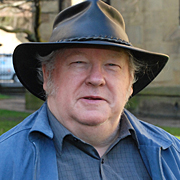
Professor Keith Laybourn
History of Greyhound Racing in Britain
Professor Keith Laybourn’s new book records the history of greyhound racing from its heyday to its gradual decline exploring its early mass appeal and constant detractors, including Winston Churchill.
ONLY a few dog tracks remain, but greyhound racing boomed in the 1920s and 30s, offering bright lights, an exciting night out and plentiful betting opportunities for the working classes. Now, a University of Huddersfield history professor had written the first full account of the rise and decline of a sport that once caused moral panic among members of the British Establishment.
It was on 24 July 1926, that the first British greyhound meeting – in which the dogs chased an electrically propelled artificial hare – took place at Belle Vue, Manchester. The sport rapidly gained popularity and within a decade there were 200 tracks that attracted total attendances of well over 32 million a year, states Professor Keith Laybourn in newly-published Going to the Dogs: A History of Greyhound Racing in Britain, 1926-2017.
“There was a genuine sense of excitement about the new sport,” writes Professor Laybourn, a leading expert on the history of Labour politics whose roster of more than 50 books and 100 articles also covers topics that include policing and working class gambling.
But while it rapidly burgeoned in popularity, greyhound racing – which made legal on-course betting widely available to urban working classes for the first time – also attracted condemnation from a wide variety of sources, including religious organisations, some zealous police officers, the National Anti-Gambling League… and Winston Churchill!
He sought to drown greyhound racing at birth, writes Professor Laybourn, and in 1927 wrote a letter to the Home Secretary warning of the dangers of what he described as “animated roulette boards”.
Going to the Dogs includes a detailed analysis of the campaigns against greyhound racing just as it charts the enormous growth of the sport, which peaked in popularity during the 1920s and 30s and enjoyed a final boom in the immediate post-war years before entering a spiral of decline caused in part by the fact that its divided governance meant it could not mount a defence against new forms of taxation.
The book’s chapters include An Ascot for the common man, in which Professor Laybourn writes that although the sport always remained a precarious venture, vilified for not being a “rational recreational activity”, in its early years greyhound racing was “a vibrant, if niche activity supported by the urban working class, accepted as part of community life, creative of a culture of owning and training a sport which, despite some low level crime, was comparatively honest.
“Above all it provided some of the working classes with an opportunity to escape the drab existence that many led and offered a bright and glitzy ‘American night out’.”
Going to the Dogs concludes with a chapter on the decline of greyhound racing, now down to barely ten per cent of the size it was at the start of the 1960s.
“Given the changes in leisure, forms of gambling and the growth of television, this was bound to occur,” writes Professor Laybourn.
“However, a combination of factors – discriminatory taxation, the rise of off-course betting and greyhound racing’s image as a cruel sport – have ensured an unexpectedly rapid rate of decline.”
And the author concludes that when the groundsman of Wimbledon Stadium – which closed in 2017 – reflected that “in about 20 years greyhound racing will be gone”, his timeframe may be rather optimistic.
- Going to the Dogs: A History of Greyhound Racing in Britain, 1926-2017, by Keith Laybourn, is published by Manchester University Press.
More Stories
Stereotypical depictions of travelling communities
Dr Jodie Matthews’s book The Gypsy Woman looks at their slanted portrayal from the 1700s to today’s TV programmes
Shakespeare taken to task for view of Plantagenets
Dr Katherine Lewis made her third appearance on the BBC Radio 4 programme In Our Time, entitled Is Shakespeare History? The Plantagenets
100-year anniversary of the Spanish Flu pandemic
October 1918 marks the centenary of the pandemic that claimed more lives than World War One
